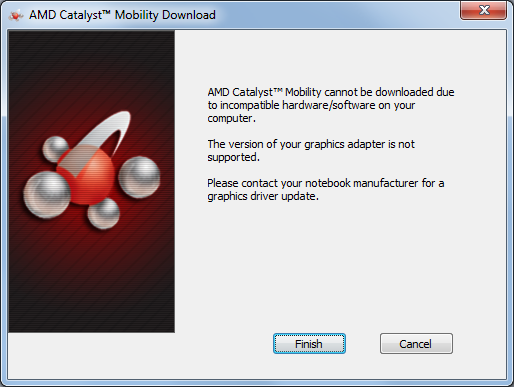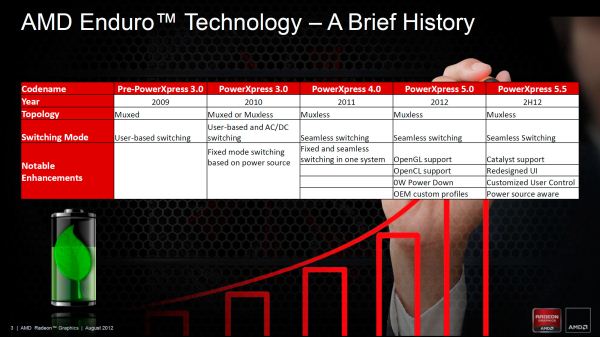AMD’s Enduro Switchable Graphics Levels Up
by Jarred Walton on September 6, 2012 3:00 AM ESTRecap: AMD’s PowerXpress, aka Dynamic Switchable Graphics, aka Enduro
Getting back to the switchable graphics, AMD has gone through a variety of names over the years. Here’s AMD’s summary slide, which I’ll discuss in detail:
Originally introduced as PowerXpress back in 2008, the first AMD switchable graphics solutions were like that found later in the ASUS UL80Vt and similar laptops: you had to flip a switch, and in the first iterations you would then need to reboot the laptop so that the BIOS could disable the discrete GPU and activate the integrated GPU. It was messy and a bit inconvenient, and NVIDIA’s early studies showed that many users ended up not using the feature—they would either run on dGPU all the time or on iGPU all the time. Both AMD and NVIDIA had a second series of switchable graphics designs where the need to reboot was removed; the first Alienware M11x could switch GPUs in about 10-15 seconds, and the same was true of HP’s first ENVY laptops. These were using PowerXpress 2.0 and 3.0, and for most people the switching side was adequate: you’d run on dGPU when plugged in and switch to iGPU when on battery power.
Last year, AMD took a step forward with their switchable graphics by introducing PowerXpress 4.0, which also renamed the technology to Dynamic Switchable Graphics (DSG for short). I got a chance to do a head-to-head of the technology using a Sony VAIO C laptop provided by NVIDIA. You know a company is confident that they’re going to win a technology comparison when they’ll actually give you a competitor’s product. In some cases, DSG was just as good as Optimus: you could launch a supported game and never realize all the extra stuff happening in the background; unfortunately, there were several titles where it wasn’t quite as convenient as we would have liked, and OpenGL support from DSG was completely missing.
Step forward to early 2012 and we got another update to PowerXpress 5.0 (note that PowerXpress is now only used internally by AMD and hasn’t been their marketing name since before PX4.0) along with a rechristening: Dynamic Switchable Graphics was out and Enduro was in. If nothing else, at least it makes my job easier as Enduro is much more concise. There's also the fact that the GPUs are no longer "switching", as the iGPU is always running; now the dGPU is simply supplementing the iGPU when needed. Along with the name change, AMD added OpenGL and OpenCL support to the mix, and with their Zero Core Technology (which is also part of their 7000 series desktop GPUs—a case of mobile design influencing desktops) the need to keep a small portion of the chip alive (aka BACO: Bus Active Chip Off) was removed. OEMs could also ship with custom profiles for applications, so for example Dell might want all of their extra utilities to default to running on the iGPU.

Hopefully this problem goes away next month!
Other than those changes, the UI and driver updates situation on early Enduro solutions remains largely the same as with DSG/PX4.0—and that’s what I initially received with the Clevo P170EM, with drivers from around March 2012. A quick check at AMD’s site also let me know that there weren’t any new drivers available, as the P170EM wasn’t currently supported by the latest Mobility Catalyst drivers.











200 Comments
View All Comments
spaceman44 - Thursday, September 13, 2012 - link
yeah its definatly in the control panel. you can also get to it by right clicking on the desktop, go to personalize, click screen saver, change power settings, change plan settings, change advanced power settings.i wrote the other directions coz it's less clicks :) and btw this is for windows 7, though i think the second path would work for xp if thats what your running.
hulawafu77 - Thursday, September 13, 2012 - link
That's just in the profiles by default. Most people play games with high performance which sets all the settings you have by default. On Clevo notebooks, in the control center, the performance setting does the same thing. Makes no difference for Enduro, not a fix.erick.mendes - Thursday, September 13, 2012 - link
External GPU for notebooks using thunderbolt from Lucid. Now that's serious power:http://www.tomshardware.com/news/lucid-gpu-graphic...
hulawafu77 - Thursday, September 13, 2012 - link
7970M is nearly 2x faster than that. The current high end notebooks outperform any eGPU solution that has been proposed so far. Though it is interesting idea, but problem is, there are 11" notebooks with a 650M. I don't see a need for eGPU anymore, it was a good idea before Kepler and GCN, but now they are here, no need. You can thing and light notebooks with powerful discrete now.carage - Tuesday, October 2, 2012 - link
I have a ViDock 4 Plus (Express Card 2.0 interface) with a GTX 670 4GB connected to my ThinkPad W520. The performance already whips a single GTX 680M. The only notebook GPU solution it doesn't beat is the GTX 680M SLI, which is not available in anything below $3,000.I think the ViDock is worth it.
Vozier - Thursday, September 13, 2012 - link
FINALLY the official news we all waited forOriginally Posted by Marc@AMD
I want to thank all those users that have been patient in this matter, and peristent in providing helpful information and feedback to the community.
We have received some positive news from the Driver Development Team. A driver is planned to be released in the near future that will provide significant improvements to notebooks enabled withAMD Enduro™ Technology.
Please stay tuned to our support.amd.com site for the driver posting.
Source: AMD Game Forums - The Clevo 7970M Enduro/under-utilization debacle
JarredWalton - Tuesday, September 18, 2012 - link
Just to update you (I'll have more to say in the P170EM review in the next two days I hope), AMD let me know that the initial public release of Enduro 5.5 should be in then next week or so. However, they are fully aware of the GPU underutilization issues and those may not be totally ironed out with the initial driver. They then plan to release a driver hotfix (probably later in October) that will address the GPU underutilization. The root issue appears to be related to transferring frames over the PCIe bus and some other areas, as when you're running at higher frame rates the problem becomes worse. So if you run DiRT 3 at Medium detail, you'll get 50% utilization while at Ultra you might get 95%, but frame rates at Medium will be lower than expected. If all goes as planned, the hotfix should take care of the problem.Vozier - Sunday, September 30, 2012 - link
Great update Jarred, even if i came along it only yesterday!On the subject, we have a small debate on NBR about the "root issue". I defend that its driver/software related and other claim its a "hardware bottleneck" (wich IMHO would be a lot worst), would you bring any light to this?
Since you mention:
"The root issue appears to be related to transferring frames over the PCIe bus and some other areas,"
thanks once again for all your help in keeping us all informed.
cheers
JarredWalton - Monday, October 1, 2012 - link
I'm honestly not sure there's a way to say for certain, but the hotfix is definitely improving performance. That would suggest that the problem is mostly related to drivers, but there could still be hardware bottlenecks. I also have to wonder if the "GPU Utilization" figures are actually getting correct data; is it possible that whatever they're polling for GPU use could sometimes report incorrect data?Vozier - Tuesday, October 2, 2012 - link
Indeed, it might be the case that some reports are wrong, I myself have tested some games with MSI afterburner measures of GPU utilization.I dont know if it can help but i have found this:
1) Recording a video capture with MSI AB or fraps gradually lowers GPU % to 30 or 40% lower than it was (after hitting alt-V or F11 in fraps), so videos made with these programs (and most likely any other video not made externally) will always show under 99% GPU and lower FPS.
2) The use of PhysX also seems to lower the GPU utilization in many cases.
3) In some games like crysis 2 or skyrim the GPU utilization varies in seconds depending on where you are looking at and wether there is a fight or not going on, this is the piece that seems to point to a hardware bottleneck. Also multiplayer games seems to be the most affected.
4) The gpu utilization usually varies a lot during video interludes and such in games, so i dont usually meassure or consider it correct or relevant in those situations.
It also seems to depend on the game, some games seem to have a "silent" Vsync of sorts that might produce lower GPU%s (NFS the run for ex doesn move from 30 FPS). Other games work perfectly (Diablo III for example never showed low GPU% with vsync off, in any game situation or fight til lvl11...)
What truly supports the driver related theory is that lowering graphic demands lowers GPU %s, and thats really weird and no hardware bottleneck should cause that, IMHO.
Bottom line is that most users want to improve FPS and performance to pair with machines that do not use enduro with the same card (i.e. 7970M), we dont really care if the GPU% is 1 as long as the numbers are equal to an AW or other notebook with the same card but no enduro. That IS the case for many games so i dont think the issue is hardware related, even if its clearly transfer related.
thanks again for all your help and input..
regards
Voz